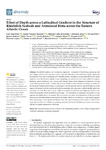Mostrar o rexistro simple do ítem
Effect of Depth across a Latitudinal Gradient in the Structure of Rhodolith Seabeds and Associated Biota across the Eastern Atlantic Ocean
| dc.contributor.author | Pérez Peris, Inés | |
| dc.contributor.author | Navarro-Mayoral, Sandra | |
| dc.contributor.author | Cosme De Esteban, Marcial | |
| dc.contributor.author | Tuya, F. | |
| dc.contributor.author | Peña, Viviana | |
| dc.contributor.author | Bárbara, Ignacio | |
| dc.contributor.author | Neves, Pedro A. | |
| dc.contributor.author | Ribeiro, Cláudia | |
| dc.contributor.author | Abreu, António | |
| dc.contributor.author | Grall, Jacques | |
| dc.contributor.author | Espino, Fernando | |
| dc.contributor.author | Bosch Guerra, Néstor Echedey | |
| dc.contributor.author | Haroun, R. | |
| dc.contributor.author | Otero Ferrer, Francisco J. | |
| dc.date.accessioned | 2023-04-24T15:55:43Z | |
| dc.date.available | 2023-04-24T15:55:43Z | |
| dc.date.issued | 2023-01-12 | |
| dc.identifier.citation | Pérez-Peris, I.; Navarro-Mayoral, S.; de Esteban, M.C.; Tuya, F.; Peña, V.; Barbara, I.; Neves, P.; Ribeiro, C.; Abreu, A.; Grall, J.; Espino, F.; Bosch, N.E.; Haroun, R.; Otero-Ferrer, F. Effect of Depth across a Latitudinal Gradient in the Structure of Rhodolith Seabeds and Associated Biota across the Eastern Atlantic Ocean. Diversity 2023, 15, 103. https://doi.org/10.3390/d15010103 | es_ES |
| dc.identifier.issn | 1424-2818 | |
| dc.identifier.uri | http://hdl.handle.net/2183/32925 | |
| dc.description | This article belongs to the Special Issue Diversity and Ecology of Marine Benthic Communities | es_ES |
| dc.description.abstract | [Abstract] Rhodolith seabeds are ‘ecosystem engineers’ composed of free-living calcareous red macroalgae, which create extensive marine habitats. This study addressed how depth influenced the structure (size and morphology) of rhodoliths and the abundance of associated floral and faunal epibionts across the Eastern Atlantic Ocean. Sampling was carried out at two sites within five regions (Brittany, Galicia, Madeira, Gran Canaria, and Principe Island), from temperate to tropical, covering a latitudinal gradient of 47°, in three depth strata (shallow, intermediate and deep), according to the rhodolith bathymetrical range in each region. Depth typically affected the rhodolith size at all regions; the largest nodules were found in the intermediate and deep strata, while rhodolith sphericity was larger at the shallow depth strata. Higher biomasses of attached macroalgae (epiphytes) were observed at depths where rhodoliths were larger. The abundance of epifauna was variable across regions and depth strata. In general, the occurrence, structure, and abundance of the associated biota across rhodolith habitats were affected by depth, with local variability (i.e., sites within regions) often displaying a more significant influence than the regional (large-scale) variation. Overall, this study showed that the rhodolith morphology and associated epibionts (flora and fauna) were mostly affected by depth, irrespective of latitude. | es_ES |
| dc.description.sponsorship | This work was partially financed by ASSEMBLE PLUS project ‘Ecological interactions between marine habitats structured by rhodolith seabeds and marine biodiversity: amphipods as indicators of global environmental changes (MARS)’ (Grant Agreement No. 730984), BIO-Príncipe 2016 Scientific Expedition, promoted by the Regional Government of Príncipe through the UNESCO Biosphere Reserve, and MACRODO (Macaronesia rhodolith beds: from factories of carbon sequestration to sensibility to environmental stressors) project supported by the LIFE Program of the European Union, the French Office for Biodiversity (OFB), and the French Development Agency (AFD) through the LIFE4BEST Program. The contents of this document are the sole responsibility of the MACRODO project and can under no circumstances be regarded as reflecting the position of the European Union nor of the OFB and AFD. Project M1420- 01-0145-FEDER-000001—Observatório Oceânico da Madeira-OOM and Portuguese national funds from FCT—Foundation for Science and Technology through projects UIDB/04326/2020, UIDP/04326/2020 and LA/P/0101/2020 | es_ES |
| dc.description.sponsorship | Portugal. Observatório Oceânico da Madeira; M1420-01-0145-FEDER-000001 | es_ES |
| dc.description.sponsorship | Portugal. Fundação para a Ciência e a Tecnologia; UIDB/04326/2020 | es_ES |
| dc.description.sponsorship | Portugal. Fundação para a Ciência e a Tecnologia; LA/P/0101/2020 | es_ES |
| dc.language.iso | eng | es_ES |
| dc.publisher | MDPI | es_ES |
| dc.relation | info:eu-repo/grantAgreement/EC/H2020/730984 | es_ES |
| dc.relation.uri | https://doi.org/10.3390/d15010103 | es_ES |
| dc.rights | Atribución 4.0 Internacional | es_ES |
| dc.rights.uri | http://creativecommons.org/licenses/by/4.0/ | * |
| dc.subject | Environmental drivers | es_ES |
| dc.subject | Vertical scale | es_ES |
| dc.subject | Latitudinal gradient | es_ES |
| dc.subject | Maerl beds | es_ES |
| dc.subject | Non-geniculate corallines | es_ES |
| dc.subject | Epibionts | es_ES |
| dc.subject | Ecosystem engineers | es_ES |
| dc.title | Effect of Depth across a Latitudinal Gradient in the Structure of Rhodolith Seabeds and Associated Biota across the Eastern Atlantic Ocean | es_ES |
| dc.type | info:eu-repo/semantics/article | es_ES |
| dc.rights.access | info:eu-repo/semantics/openAccess | es_ES |
| UDC.journalTitle | Diversity | es_ES |
| UDC.volume | 15 (2023) | es_ES |
| UDC.issue | 1 | es_ES |
| UDC.startPage | 103 | es_ES |
| dc.identifier.doi | 10.3390/d15010103 |
Ficheiros no ítem
Este ítem aparece na(s) seguinte(s) colección(s)
-
GI- BIOCOST - Artigos [45]
-
OpenAIRE [287]






